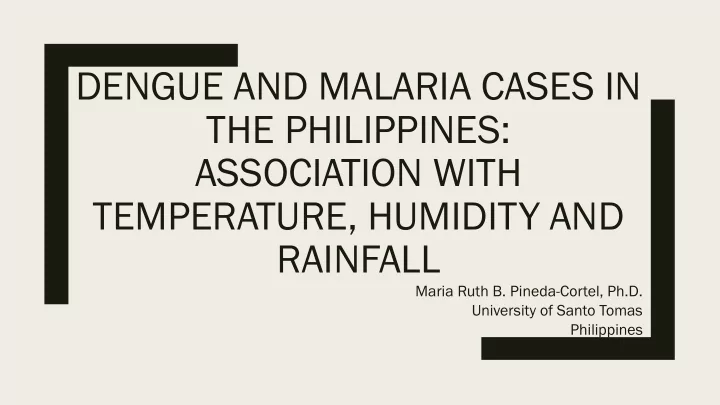

DENGUE AND MALARIA CASES IN THE PHILIPPINES: ASSOCIATION WITH TEMPERATURE, HUMIDITY AND RAINFALL Maria Ruth B. Pineda-Cortel, Ph.D. University of Santo Tomas Philippines
Objectives of the Study Identify trends, distribution patterns, and relations among diseases, variability of climate and socio- economic conditions ■ Present the number of cases of dengue and malaria from 2008 to 2015 in the Philippines: trends and patterns ■ Determine if climate factors (temperature, rainfall and humidity) are significantly associated with dengue and malaria cases in the Philippines – percent of the cases contributed by the climate factors – climatic factor with greatest effect on the prediction of dengue and malarial ■ Determine effect of socio-economic conditions on the cases
Conceptual Framework INDEPENDENT VARIABLE CLIMATE FACTORS RELATIVE HUMIDITY MEAN TEMPERATURE RAINFALL DEPENDENT VARIABLE DENGUE AND MALARIA CASES
Data Collection ■ Data on climatic factors were obtained from PAGASA – mean temperature, amount of rainfall, and relative humidity ■ Data on dengue and malaria cases were obtained from DOH and from different regions in the Philippines – 2008 to the third quarter of 2015
Statistical Analysis ■ Time series and structural analysis using Eviews 9.5 SV ■ Augmented Dickey Fuller (ADF) was used to test for stationarity ■ Granger causality was used to investigate causality between two variables
Total Dengue Cases (2008-2015) 200000 900 180000 800 160000 700 140000 600 120000 500 100000 400 80000 300 60000 200 40000 100 20000 0 0 Mortality Morbidity
NC NCR Regio gion n IVA
Region I Regio gion n III
Suspected Dengue Cases in the Philippines per Region (2008-2015) • Low: 2008, 2009 and 2014 • Spike: 2010, 2011, 2012, 2013 and 2015 • Highest: July to September • Lowest: April and May • Region 6 has the highest count of suspected dengue case, on August 2010. OVERALL: NCR, Region 3 and 4a
Suspected Dengue Death Cases in the Philippines per Region (2008-2015) • exhibit similar pattern with that of morbidity cases • 2010, 2011 and 2015 • Highest: July to September • Lowest: April and May • OVERALL: NCR, Region 4a and Region 7
Total Suspected Malaria Cases in the Philippines (2008-2015) Tot otal Suspe pect cted ed Malaria a Cases es (2008 08- 2015) 5) 8000.00 7000.00 6000.00 5000.00 4000.00 3000.00 2000.00 1000.00 0.00
Suspected Malaria Cases in the Philippines (2008-2015) • Lower cases than dengue • Region 4b has extreme suspected cases of Malaria • Palawan (1,401; 5) • Occidental Mindoro (490; 5) • Oriental Mindoro (383; 1) • Romblon (244; 0) • Marinduque (204; 2)
Minimum and Maximum Temperatures Min. Temp. Rel. Hum. Rainfall Ave. Rf Max. Temp. Ave. Temp. and Rh
Association/Correlation with Climatic Factors Correlation Min Temp Max Temp Rainfall Humidity .135 ** .237 ** .173 ** Dengue -.044 .173 ** .160 ** .063 * Dengue Deaths -.040 .125 ** .061 * -.067 ** Malaria .042 **. Correlation is significant at the 0.01 level (2-tailed). *. Correlation is significant at the 0.05 level (2-tailed). Dengue, dengue deaths and malaria cases are associated with the minimum temperature of the area. As the Minimum temperature increases, the Dengue, dengue deaths and malaria cases also increases. Dengue is positively related to amount of rainfall, i.e. as rainfall increases, dengue and dengue deaths also increases. However malaria has a different direction. As the rainfall increases the malaria cases decreases. For the relative humidity, only dengue is related. As humidity increases, dengue and dengue deaths also increase.
Dengue Cases and Minimum Temperature, 2015 Pos osit itiv ive e 4500 25.00 as asso sociati iation on of 4000 dengue with 20.00 3500 minimum 3000 15.00 temperature 2500 2000 10.00 1500 1000 5.00 500 p = 0.135 ** 0 0.00 p = .173 ** Dengue Cases Min Temp
Dengue Cases and Rainfall, 2015 Dengue 4500 1200.00 Cases are 4000 1000.00 positively 3500 3000 800.00 associated 2500 with amount 600.00 2000 of rainfall 1500 400.00 1000 200.00 500 p = 0.237 ** 0 0.00 p = 0.160 ** Dengue Cases Rainfall
Dengue and Relative Humidity, 2015 4500 94.000 Dengue 92.000 4000 Cases are 90.000 3500 positively 88.000 3000 86.000 associated 2500 84.000 with relative 82.000 2000 humidity 80.000 1500 78.000 1000 76.000 500 74.000 0 72.000 p = 0.173 ** p = 0.063 * Dengue Cases Humidity
Malaria, Temperature and Rainfall, 2015 1200 25.00 Malaria is positively 1000 20.00 associated 800 with 15.00 temperature 600 10.00 and 400 negatively 5.00 200 associated with rainfall. 0 0.00 Malaria Cases Rainfall Min Temp
Stationarity time series ■ Augmented Dickey Fuller ■ Some series are detected to be non-stationary. – Minimum Temperature in Regions 1, 2, 3, CAR and ARMM; – Malaria cases in Region 13 and Humidity in Region 10. – This means that these series are not constant over time and there is a presence of seasonality. Seas asonality onality an and tr trend nd me mean ans s th that at th there re ar are co common mmon mo months ths th that at deng ngue ue ca cases es ar are high h an and some me mo months ths ha have e th the e sma mall ll numb mber er of ca cases. es.
Granger Causality ■ A test to check if certain factors may be used to predict number of cases For dengue: ■ Minimum temperature contains information that can predict the number of Dengue cases (in most regions, except 8 and ARMM) ■ Rain infall l (3, 4a, 4b, 7, 9, NCR) ■ Humidity (11 only) For malaria: ■ min. temp. and rainfall can predict cases of Malaria in Reg egio ion 4b onl nly
Acknowledgments – Asia Pacific Network for Global Change Research (APN) ■ Department of Health (DOH) ■ Philippine Atmospheric, Geophysical, and Astronomical Services Administration (PAGASA) ■ University of Santo Tomas (UST)
Recommend
More recommend